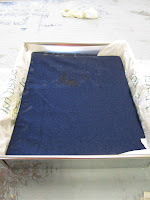I boiled white flour for about half hour mixing water into it. It smelled like dough. :)
There were lots of chunks in it, not fully smooth. Maybe it needed to be blended with a blender to get all the chunks out. But the consistency was quiet thin and with that the print came out more consistent as opposed to blotchy with the indalca. I even tried the indalca thinned out, but the color didn't transfer from that.It printed a light color. The Henna printed darker than the Rosewood. But all in all, it was an interesting day.
I liked the print on the silk the most when it was wet. Obviously when it got dry, it wasn't as contrasty but it was still visible and the fabric is somewhat stiff since we have not mordanted any of the fabrics.
Here are the pictures.


















